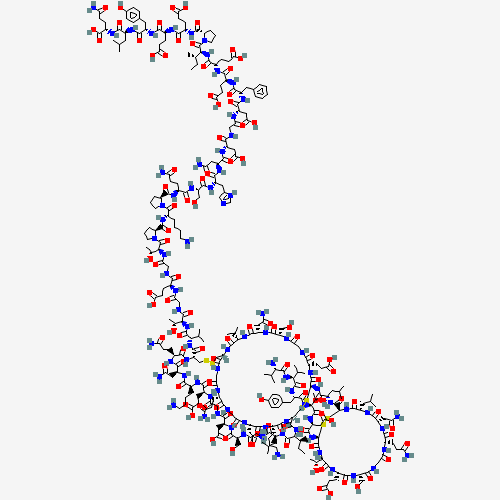| Pharmaceutical Information |
| Drug Name |
Desirudin |
| Drug ID |
BADD_D00614 |
| Description |
Desirudin is a direct inhibitor of human thrombin. It has a protein structure that is similar to that of hirudin, the naturally occurring anticoagulant present in the peripharyngeal glands in the medicinal leech, Hirudo medicinalis. Hirudin is a single polypeptide chain of 65 amino acids residues and contains three disulfide bridges. Desirudin has a chemical formula of C287H440N80O110S6 with a molecular weight of 6963.52.
It is mainly indicated for the prevention of deep vein thrombosis in hip replacement surgery patients.
Common side effects include: Bleeding gums, collection of blood under the skin, coughing up blood, deep, dark purple bruise and difficulty with breathing or swallowing. |
| Indications and Usage |
Indicated as prophylaxis of deep vein thrombosis for patients undergoing hip replacement surgery. |
| Marketing Status |
approved |
| ATC Code |
B01AE01 |
| DrugBank ID |
DB11095
|
| KEGG ID |
D03692
|
| MeSH ID |
C060225
|
| PubChem ID |
16129703
|
| TTD Drug ID |
D00UOR
|
| NDC Product Code |
Not Available |
| UNII |
U0JZ726775
|
| Synonyms |
desirudin | desulphatohirudin | recombinant HV1 hirudin | desulfatohirudin | Iprivask | IK-HIR02 | CGP 39393 | CGP-39393 | Revasc |
|
| Chemical Information |
| Molecular Formula |
C287H440N80O110S6 |
| CAS Registry Number |
120993-53-5 |
| SMILES |
CCC(C)C1C(=O)NC(C(=O)NCC(=O)NC(C(=O)NC(C(=O)NCC(=O)NC(C(=O)NC(C(=O)NC(C(=O)NC(C(
=O)NC(CSSCC2C(=O)NCC(=O)NC(C(=O)NCC(=O)NC(C(=O)NC(C(=O)NC(CSSCC(C(=O)NC(C(=O)NCC
(=O)NC(C(=O)NC(C(=O)NC(C(=O)N2)C(C)C)CC(=O)N)CO)CCC(=O)O)NC(=O)C(CC(C)C)NC(=O)C3
CSSCC(C(=O)NC(C(=O)NC(C(=O)NC(C(=O)NCC(=O)NC(C(=O)NC(C(=O)NC(C(=O)N3)CC(C)C)CC(=
O)N)CCC(=O)N)CO)CCC(=O)O)C(C)O)NC(=O)C(CC(=O)O)NC(=O)C(C(C)O)NC(=O)C(CC4=CC=C(C=
C4)O)NC(=O)C(C(C)C)NC(=O)C(C(C)C)N)C(=O)N1)CCCCN)CC(=O)N)CCC(=O)N)C(=O)NC(C(C)C)
C(=O)NC(C(C)O)C(=O)NCC(=O)NC(CCC(=O)O)C(=O)NCC(=O)NC(C(C)O)C(=O)N5CCCC5C(=O)NC(C
CCCN)C(=O)N6CCCC6C(=O)NC(CCC(=O)N)C(=O)NC(CO)C(=O)NC(CC7=CN=CN7)C(=O)NC(CC(=O)N)
C(=O)NC(CC(=O)O)C(=O)NCC(=O)NC(CC(=O)O)C(=O)NC(CC8=CC=CC=C8)C(=O)NC(CCC(=O)O)C(=
O)NC(CCC(=O)O)C(=O)NC(C(C)CC)C(=O)N9CCCC9C(=O)NC(CCC(=O)O)C(=O)NC(CCC(=O)O)C(=O)
NC(CC1=CC=C(C=C1)O)C(=O)NC(CC(C)C)C(=O)NC(CCC(=O)N)C(=O)O)CCC(=O)N)CC(=O)N)CCCCN
)CCC(=O)O)CC(=O)O)CO)CC(C)C |
| Chemical Structure |

|
|
| ADRs Induced by Drug |
|
|
*The priority for ADR severity classification is based on FAERS assessment, followed by the most severe level in CTCAE rating. If neither is available, it will be displayed as 'Not available'.
**The 'Not Available' level is hidden by default and can be restored by clicking on the legend twice..
|
|
|

